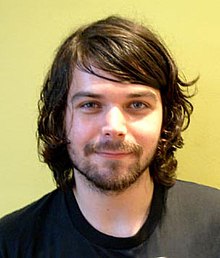Simon Neil
Simon Neil | |
|---|---|
 | |
| Background information | |
| Birth name | Simon Alexander Neil |
| Born | 31 August 1979 Irvine, North Ayrshire, Scotland |
| Origin | Irvine, North Ayrshire, Scotland |
| Genres | Alternative rock, post-hardcore |
| Occupation(s) | Singer, songwriter, record producer |
| Instrument(s) | Vocals, guitar, bass guitar, banjo, mandolin, sitar, piano, saxophone, harmonica, melodica, mellotron, synthesizer |
| Years active | 1995–present |
| Labels | Beggars Banquet 14th Floor Roadrunner |
| Website | www.biffyclyro.com |
Simon Alexander Neil (born 31 August 1979) is a Scottish vocalist, guitarist, and songwriter.
He is known for his work in the bands Biffy Clyro and Marmaduke Duke.
Career
Biffy Clyro

Born in Irvine, North Ayrshire, Scotland, Simon Neil formed Biffy Clyro in 1995 at 15 years old recruiting Kilmarnock-born James Johnston and someone known only as Barry on bass and drums respectively, calling themselves Screwfish.[1] Barry was soon replaced by Ben Johnston, James's twin brother, and Biffy Clyro was effectively formed. In 1997, the trio moved to Glasgow, where Neil studied Electronics with Music at the University of Glasgow. He also Studied Film and TV for a year before leaving to pursue music full-time. By then, Simon's musical tastes had expanded; In 2000, the band were spotted at the Unsigned Bands stage at T in the Park by a Beggars Banquet representative. Soon after, the band was signed to the independent Beggar's Banquet.
Biffy Clyro have since released six albums, signed to a major record label, and toured relentlessly. Neil has stated that Biffy Clyro lyrics often come from phrases he writes down in a notebook he keeps by his bed.
Marmaduke Duke
Neil plays with JP Reid of fellow Ayrshire group Sucioperro in Marmaduke Duke, under the pseudonym "The Atmosphere", which released their first album, The Magnificent Duke, in 2005.
It was announced in late 2008 that the Duke was to make a return in 2009 with the follow-up album and second in the trilogy, Duke Pandemonium. The first single from the second album, "Kid Gloves" was released on 9 February 2009.
Solo career
Neil performs under the name ZZC. His debut single, "To The Bone", was used in the BBC’s ‘Radio 1 Rescores: Drive (curated by Zane Lowe)’ project.
Personal life

Neil lives in Ayr with his wife Francesca, whom he married at St Columba Church in Ayr on 5 January 2008. A tattoo on Neil's chest, God Only Knows What I’d Be Without You, refers both to the Beach Boys song lyric and to his Wife. It was the first song they danced to.[2]
Musical equipment used
The following is a list of musical equipment used by Simon Neil:
Guitars
Electric
- Fender Standard Stratocasters[3] – Various different Mexican models, including White, Red, Sunburst (with neck pickup & controls removed), Black, and Metallic Blue.
- Fender 1960 Custom Shop Stratocasters[3] – Fiesta Red, Frost Metallic, Lake Placid Blue, and White.
- Fender 50s Stratocaster Relic[3]
- Fender Telecaster Standard[3] – USA model, owned by James Johnston, three tone sunburst, can be seen in the music video for "Living is a Problem Because Everything Dies".
- Fender Telecaster Custom '62[3] – Japanese model, three tone sunburst, can be seen in the music video for "Only one word comes to mind".
- Squier Simon Neil Signature Stratocaster[3]
- Patrick Eggle New York[3] – Red.
- Gretsch White Falcon Used live for the song "Diary of Always" and is seen in the music video for "Folding Stars"
- Gibson ES-335 – used live for "God & Satan".
Effects pedals
- BOSS TU-2 Chromatic Tuner[3]
- BOSS MD-2 Distortion[3]
- BOSS MT-2 Metal Zone[3]
- BOSS DD-6 Digital Delay x2 [3]
- BOSS LS-2 Line Selector[4]
- Electro Harmonix Micro POG[4]
Previous effects pedals
- BOSS DS-1 Distortion[3]
- BOSS HM-2 Heavy Metal[3]
- Dunlop Cry Baby Wah Wah[4]
Amplifiers
- Peavey Delta Blues Combo[3] into a Marshall MF400B Cabinet[3]
- Fender Hot Rod Deville 4x10 Combo[3] into a Hayden Peacemaker 4x12[3]
- Marshall 1959SLP Head[3]
- Peavey Classic Head[3] and Peavey Classic 412 Cabinet[3]
- Hayden MoFo 30W tube head with Hayden 4x12[3]
References
